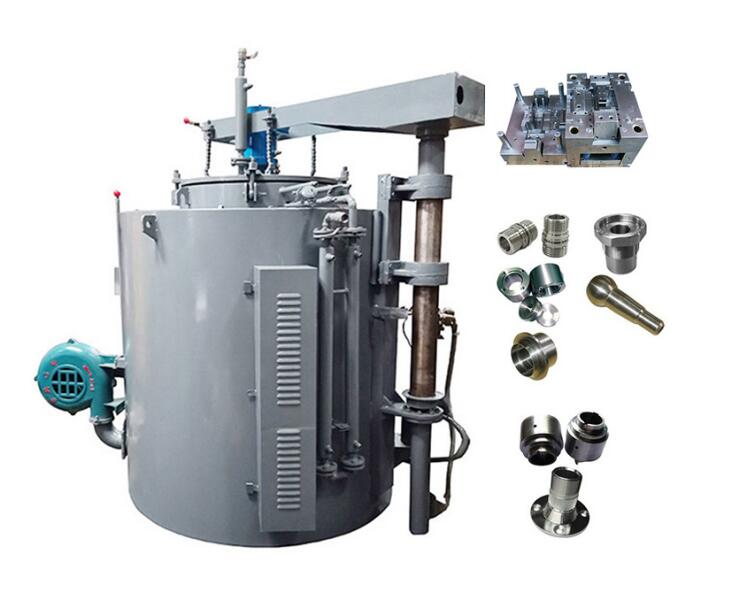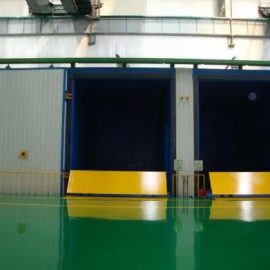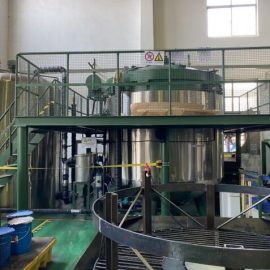Pit Type Gas Nitriding Furnace Process Operation Specification
Principles for determining preparatory processing:
Generally, structural steel parts are quenched and tempered. The high temperature tempering temperature should be 20~40 °C higher than the nitriding temperature, and the holding time should not be too long.
For parts with low impact toughness requirements, normalizing can be used, but the cooling rate of normalizing is faster, and parts with larger cross-sectional dimensions should not be normalized.
38CrMoAl steel should be quenched and tempered, otherwise needle-like nitrides are likely to appear in the infiltrating layer. Before nitriding, the tool and die steel must be quenched and tempered, and annealing is not allowed.
For slender, thin-walled, complex and precise parts, one or more stress relief treatments must be performed before nitriding. The stress relief temperature is generally lower than the quenching and tempering temperature, but higher than the nitriding temperature. If the deformation is out of tolerance after treatment , after the correction, the stress is removed again according to the original process, until the deformation is completely qualified.
Furnacepreparation
1) Before nitriding, conduct a comprehensive inspection of the temperature control instrument, liquid ammonia bottle, flow meter, ammonia decomposition analyzer, and various pipeline systems to ensure the normal operation and use of the equipment. The temperature difference in the furnace should be less than 10 °C.
2) Calcium oxide, calcium chloride, etc. are commonly used as desiccants, and calcined calcium oxide is commonly used. If it fails, it should be replaced or dried.
3) It is better to use liquid ammonia whose volume fraction of nitriding medium water is less than 0.2%.
4) Prepare the spreader according to the shape, size, quality and technical requirements of the parts, carefully check whether it is in good condition and reliable before use, and clean it.
Preparation of parts
1) The surface roughness of nitriding parts should be less than Ra1.6μm, and the surface should not have defects such as scratching, bumping and rusting. Parts that cannot be treated in time must be oiled to avoid rusting.
2) For parts that are easily distorted, the amount of distortion should be predicted and recorded.
3) The material and pre-heat treatment of the sample are the same as the parts, the size of the sample is ф(20~30)mm×(6~10)mm, the sample is 3~5 pieces, and the numbers are placed in different representative positions .
4) Carefully clean the parts, and clean them with clean gasoline when they are hoisted into the furnace to ensure the cleanliness of the parts.
5) Put the cleaned parts into the nitriding furnace. The slender rods that are easily deformed must be hung vertically with uniform spacing, do not block the exhaust holes, and the parts must not exceed the scope of the effective heating area.
Determination of process specifications:
Nitriding temperature
1) 500~530℃ is commonly used, which can ensure that the nitride has a larger dispersion and the highest hardness.
2) As the nitriding temperature increases, the depth of the nitriding layer increases, while the hardness decreases significantly. When nitriding is greater than 550°C, the highest hardness of most steel grades is lower than 1000HV.
3) When two-stage or three-stage nitriding is used, the temperature of the second stage is often lower than 560°C.
Nitriding time
1) The nitriding layer thickens with the prolongation of nitriding time. The initial growth rate is large, and then gradually slows down, following the parabolic law, and the general penetration rate is about 0.01mm/h
2) As the holding time prolongs, the nitrides aggregate and grow, and the hardness decreases. The higher the temperature and the longer the time, the stronger the growth.
Ammonia decomposition rate
1) The ammonia decomposition rate is better controlled at 25%~40%, the active nitrogen atoms are the most, and the surface of the parts absorbs a large amount of nitrogen.
2) The decomposition rate of ammonia exceeds 60%, and the volume fraction of hydrogen in the atmosphere reaches 52%, resulting in denitrification. A large number of nitrogen molecules and hydrogen molecules stagnate on the surface of the parts, so that nitrogen atoms are not absorbed and the infiltration layer is thinned.
3) For one-stage or two-stage nitriding, the decomposition rate of strong ammonia is 18%~30%, and the ammonia decomposition rate during diffusion is ideally 40%~60%.
Nitriding operation:
Heating: Before heating, the ammonia gas should be exhausted, and the ammonia gas flow rate is more than 2 times of the normal flow rate. If the deformation requirements are strict, step heating should be adopted, and the temperature should be kept at 200~250°C and 400~450°C for 1~2h each. Make the heating rate less than 50℃/h, and when approaching the holding time, the amount of ammonia should be increased so that the decomposition rate is controlled at the lower limit of the process requirements.
Exhaust: Generally, exhaust while heating up, and empty at 150~200°C. During the exhaust process, you can use pH test paper (the test paper is soaked with water, and turns blue in case of ammonia gas) or glass rod (glass rod dipped in salt and exposed to salt) Ammonia gas has white smoke discharged) method to check the sealing condition of furnace tank and pipeline.
In the exhaust stage, ammonia gas is continuously introduced to make the furnace gas pressure reach 200~400Pa. Since ammonia gas is easily soluble in water, oil is usually placed in the U-shaped pipe for measuring the ammonia decomposition rate. In the nitriding tank, the air is not clean, and the exhaust pipe cannot be ignited. In the heating stage, the ammonia decomposition rate can reach 70%. When the volume fraction of ammonia in the furnace gas is greater than 95%, the ammonia flow can be reduced, and the positive temperature in the furnace can be maintained. pressure.
Heat preservation: When the temperature reaches the specified temperature of the process, adjust the ammonia flow to control the ammonia decomposition rate to 18%~35%, and start to calculate the heat preservation time. At this time, the furnace pressure is 200~600Pa. During the nitriding process, the ammonia The ammonia decomposition rate is controlled by the flow rate method. Generally, the ammonia decomposition rate is measured every 15~30 minutes. During the heat preservation process, the upper and lower deviation of the furnace temperature should be less than 5 °C. necessary analysis.
Denitrogenation cooling: After the entire nitriding stage, close the exhaust valve, reduce the ammonia flow, and keep the temperature for 2 hours, so that the ammonia decomposition rate is greater than 70%, so that the nitrogen concentration on the surface of the parts is reduced, and the surface brittleness is reduced. After the power outage to cool down, continue to pass a small amount of ammonia gas into the furnace to keep the furnace at positive pressure. When the furnace temperature drops below 150 ℃, the supply of ammonia can be stopped and the parts should be released from the furnace to avoid collision.

Effect of Tension Annealing-Induced Anisotropy on Magnetic Properties of Nanocrystalline Alloys Several Matters Needing Attention In Gas Nitriding Process Deformation Analysis Of Carburizing And Quenching



Contact us
Your email address will not be published. Required fields are marked *